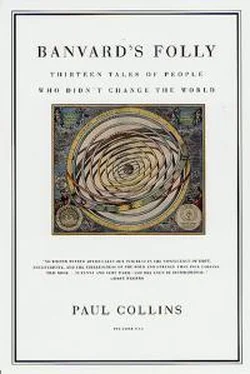Still, a few systems clung to life. Amazingly, the Royal Mail still uses a few of its air-driven lines in London. A vogue for message-bearing "pneus"
developed in Paris and remnants of the Prague pneumatic mail system remain in use to this day. One of the few stateside survivors is the tube system in the New York Public Library; it is used to convey book requests from Room 315 to workers in the vast catacombs below.
Pneumatic passenger trains, though, have vanished entirely. The Whitehall and Waterloo passenger line, the offspring of the enthusiastic reception given to the Crystal Palace exhibition, actually did break ground and begin tunneling
beneath London. But the venture was swamped by an economic slump in 1866, and the half-finished tunnel was never demolished or filled in. It now sits eternally entombed somewhere beneath the sidewalks of Whitehall.
But occasionally the notion of pneumatic passenger lines is disinterred. Even as pneumatics went out of favor, in 1877 the journal Nature carried a hopeful notice for the formation of a company to build a pneumatic railway between South Kensington Station and the Royal Albert Hall. In the 1940's the Nobel physicist Irving Langmuir floated the idea of a 5,000-mph rocket-assisted pneumatic railway running from Manhattan to San Francisco, and in 1965, Scientific American returned to its roots by running a plan for a 300-mph intercity atmospheric network. But, like every other pneumatic proposal, these railways in the air had the same terminus: nowhere.
The Beach Pneumatic Transit Company staggered on for years. The Broadway tunnel was hired out for a while as a shooting range and then a wine cellar, and then simply sealed up. Beach's interest waned with the defeat of pneumatics, and the company went on to abandon air pumps for steam and electric engineering schemes that might actually see some return on their huge venture-capital expenditures. The company became the Broadway Underground Railway Company in 1874, and then the New York Arcade Railway Company in 1885.
Each name change reflected a vast new engineering scheme, and hence a new round of lobbying and debilitating lawsuits from rivals in the railway business.
Alfred Beach died in 1896, and the next year his old company gave up any pretension to winning contracts to build passenger service--it would now be the New York Parcel Dispatch Company. It struggled feebly for the next decade to secure any sizable business, and failed utterly.
In 1912, long after the contests of Boss Tweed's days were forgotten and the Beach line but a distant memory, the city of New York announced plans to build a new subway station at City Hall. From out of the void, a letter arrived at the subway commission's office:
New York City, February 19, 1912
Notice is hereby given that the tunnel under Broadway from Warren Street southward about two hundred and ninety-four (294) feet in the Borough of Manhattan, City, County, and State of New York, is the property of the New York Parcel Dispatch Company, that anyone molesting or interfering therewith will be proceeded against as a trespasser and that the rights of the owner will be enforced in the courts. New York Parcel Dispatch Company Eugene W.
Austin, President
But nobody knew or cared about Beach anymore. And so with the shattering of brick and the splintering of wood, one day the subway sandhogs came crashing and stumbling through the darkness and into a pitch-black recess.
It was Beach's old tunnel.
Lights were brought in, and the awed workers looked around. The tunnel had been sealed for forty years now, and yet all was ready for another run.
Workers shining their electric lights into the sumptuous parlor found that it lay untouched and entombed in a layer of dust, its soft divans still awaiting the impress of the next visitor's body. Nor had the tunnel leaked or caved in, for the air inside it was warm and dry. At the far end of the tunnel was Beach's wondrous excavating shield, still waiting its next push, ready to go all the way across the city and under the East River. Its wooden frame disintegrated to the touch.
And farther back, inside the tunnel, a vehicle awaited its next run. The pneumatic train, decomposed with dry rot, was still sitting on the tracks, waiting for a rush hour that would never come.
HE BEING DEAD YET SPEAKETH NOT
Predicting literary reputations is a tricky business. When I was a student at the College of William and Mary, a conservative student newspaper ran a dismissive article headed:
MAYA ANGE-WHO?
Visiting Poet Hardly a Household Name
About a year later, Angelou intoned her poem "On the Pulse of Morning" at President Clinton's inauguration. The poem became a best-selling book, and she became ... well, a household name.
There is a problem with being a household name, though, and that is that sometimes the household disappears. When we peruse modern editions of old literature, we are not reading literature as people of that time experienced it. We are only reading it as we experience it. To understand the literature of an era as it was known by its own inhabitants, you need to leaf through the actual physical objects of the era, the crumbling acid-rich paper of old books and periodicals.
Read the contents pages of these literary magazines, annuals, or book catalogs. It is a bewildering experience. You might not see any names you recognize; the authors that today we consider the geniuses of an age may have been unknown in their own time, while others who were then considered the pillars of an era have toppled into the dust. History has not changed, but what we wish to remember from it has.
So were you to think on one of the best-selling poets of the nineteenth century--a man who sold upwards of 1.5 million copies, and was proclaimed by Britain's Spectator as having "won for himself the vacant throne waiting for him amidst the immortals ... adopted by the suffrage of mankind and the final decree of publishers into the same rank with Wordsworth, Tennyson, and Browning"--you might think of Coleridge, Keats, or perhaps Longfellow. They have all passed into worthiness, to be engraved into library cornices and published in cheap student editions. Yet the poet we seek was not any of these men. He is not anybody at all, as far as most readers are concerned, for his works have been out of print for over a century now. It would have been hard for him or anyone else to believe this, for he once seemed unassailable in his position as the most beloved poet in Britain.
Martin Farquhar Tupper was not meant to be a poet. Born in 1810, the son of a successful London physician, he was groomed from an early age for a respectable career as a clergyman or a barrister. First he was sent to the petty tyrannies of boarding school at Charterhouse--"Slaughterhouse," his disgusted classmate Thackeray preferred to call it--where he was exposed to both the classics and the sight of a sadistic schoolmaster "smashing a child's head between two books in his shoulder-of-mutton hands till his nose bled."
From Charterhouse he was packed off to Christ Church College at Oxford, where he could enjoy much the same view over the quadrangle as George Psalmanazar once had over a century before.
Tupper immersed himself in his studies, spending his spare time pondering theology and poetry, and taking earnest stands like refusing to eat any sugar
"by way of somehow discouraging the slave-trade." He was an unusually industrious and sober student, so much so that the young Duke of Hamilton delighted in torturing his pious Christ Church classmate by always using Tupper's name when he signed in late after carousing. But then Tupper was always surrounded by classmates who, though more cavalier in their studies, seemed marked out for greater destinies. In his course on Aristotle his classmates were three future bishops, three future governors general of India and Canada, a future chancellor of the exchequer, and future Prime Minister William Gladstone. One simple problem held Tupper back from dreaming of a fate as lofty as theirs.
Читать дальше











